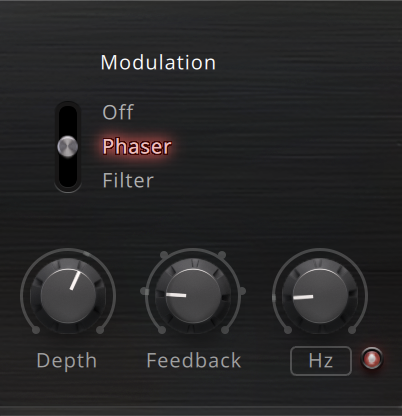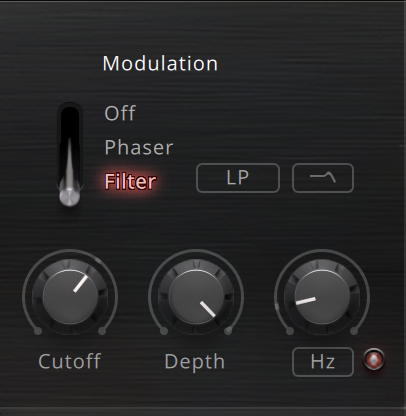Modulation Section
The effects in the Modulation section enable you to further sculpt the sound of your delays, which greatly expands REPLIKA's sonic potential.
The effects available in the Modulation section allow you to further sculpt the sound of your delays, which greatly expands REPLIKA's sonic potential. They can be freely combined with any of the delay styles available in the Style section. Each modulation effect has a unique set of parameters that enables you to change how it affects the delay sound.
The following effects are available:
Phaser
The phaser as an effect both in the studio and on stage is most commonly used for guitars but also keyboards and synthesizers. It creates harmonically unrelated peaks and troughs that move through the frequency spectrum, resulting in a unique filtering effect that smears the sound in interesting ways.
 |
Depth: Adjusts the intensity of the phasing effect, creating peaks and troughs in the frequency spectrum.
Feedback: Adjusts the amount of feedback, or resonance, applied to the all-pass filters that create the phasing effect. Turning up Feedback makes the peaks and notches in the frequency spectrum more pronounced.
Modulation Rate: Adjusts the frequency of the modulation applied to the effect. When Hz/Note is set to Note, the Modulation Rate is set in musical intervals relative to the tempo of the DAW.
Hz/Note: Switches between free (Hz) and synchronized (Note) operation for the Modulation Rate control.
Filter
Resonant filters are commonly used in synthesizers to shape the sound of the raw waveforms. The filter is applied to the delay signal, allowing you to create anything from subtle shifts in timbre to dramatic resonances and oscillations. All common filter modes are available, and the internal modulation can be used to create very animated sounds.
 |
LP/HP/Notch: Switches between three different filter modes that determine the basic sound character, LP (low-pass), HP (high-pass), and Notch.
Resonance: Switches between three different resonance amounts of the filter, no resonance, mild resonance, and strong resonance.
Cutoff: Adjusts the cutoff frequency. Depending on the setting of the LP/HP/Notch selector frequency content is attenuated above the cutoff frequency (LP), below the cutoff frequency (HP), or at the cutoff frequency (Notch).
Depth: Adjusts the intensity of the modulation applied to the effect.
Modulation Rate: Adjusts the frequency of the modulation applied to the effect. When Hz/Note is set to Note, the Modulation Rate is set in musical intervals relative to the tempo of the DAW.
Hz/Note: Switches between free (Hz) and synchronized (Note) operation for the Modulation Rate control.